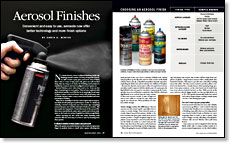Aerosol Finishes
Convenient and easy to use, aerosols now offer better technology and more finish options
Synopsis: This primer on aerosol finishes dispels many widely held myths. It discusses the availability and quality of a variety of spray finishes: varnish, lacquer, stains, toners, water-based finishes, and precatalyzed finishes. Professional finisher Chris Minick compares the lasting qualities of aerosol lacquer and varnish with brush-ons, and he gives explicit directions for applying all types of aerosol finishes with safe and even results.
From Fine Woodworking #162
No doubt about it; I am a confirmed finishing junkie. My finishing arsenal consists of a bevy of expensive brushes, half a dozen spray guns and more cans of finish than I care to count. It may seem odd, given my well-stocked shop, that my weapon of choice for finishing small projects is usually the common and much maligned aerosol spray can.
Aerosol finishes aren’t what they used to be. Gone are the days of sputtering low-tech paints. They’ve been replaced with professional-quality wood finishes in an amazingly broad array of types. A trip to your local home center will reveal spray cans of varnish, lacquer, stains, toners, water-based finishes and even precatalyzed finishes.
What about durability? It doesn’t seem logical that an easy-to-use finish should yield good performance results. To satisfy my curiosity, I started a long-term test a few years ago comparing aerosol lacquer and varnish with their brush-on cousins. The test results are impressive: I found that most of the aerosol finishes have essentially the same stain, scratch and solvent resistance as the brush-on variety, if applied in a thick-enough finish.
Before learning the few tricks that make finishing with aerosols effective and easy, it is best to start by learning how they operate.
When the spray-can nozzle (known as the actuator in spray-can lingo) is pushed down, a small valve opens, allowing the head pressure in the can to force a mixture of finish resin, solvent and propellant up the dip tube and out of the nozzle. As the finish solution leaves the tip, a liquefied propellant instantly vaporizes, exploding the finish and solvent mixture into millions of droplets.
Because the dip tube and actuator orifice of a typical aerosol can are rather small compared with the similar parts of a spray gun, the liquid finish in the can must be very thin to spray properly. Consequently, most aerosol finishes contain less than half the solids and significantly more solvent than the same volume of their non-aerosol cousins. A ratio of high solvent to low solids is a recipe for runs, drips and sags if ever I heard one. These problems are easily avoided, though.
Aerosol cans are not all created equal, especially when it comes to nozzle design. Some aerosols spray an evenly shaped tapered fan pattern similar to the best conventional spray guns, while basic aerosol nozzles produce a simple doughnut-shaped cone pattern. In my experience, aerosol nozzles that fan out the finish are easier to control and provide fewer runs than those that spray conical patterns.
For the full article, download the PDF below.
Fine Woodworking Recommended Products

Bumblechutes Bee’Nooba Wax

Odie's Oil

Bessey EKH Trigger Clamps























Log in or create an account to post a comment.
Sign up Log in